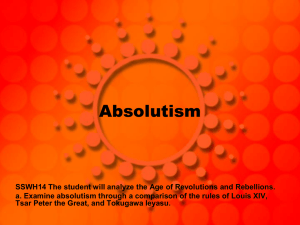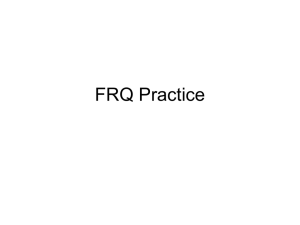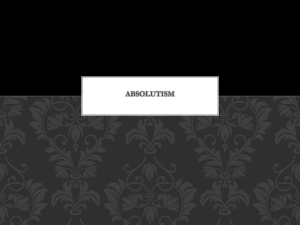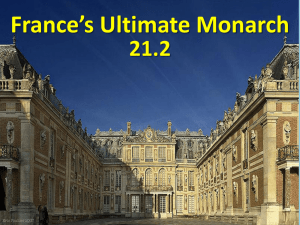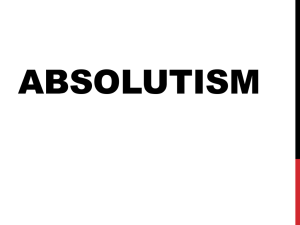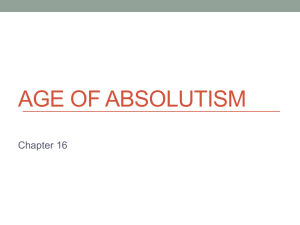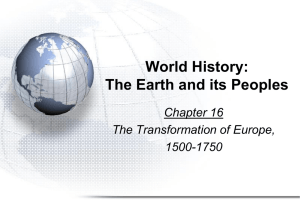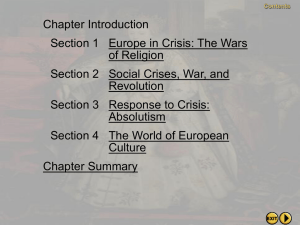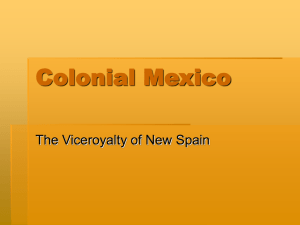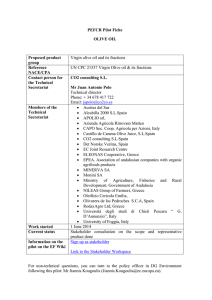ch 14
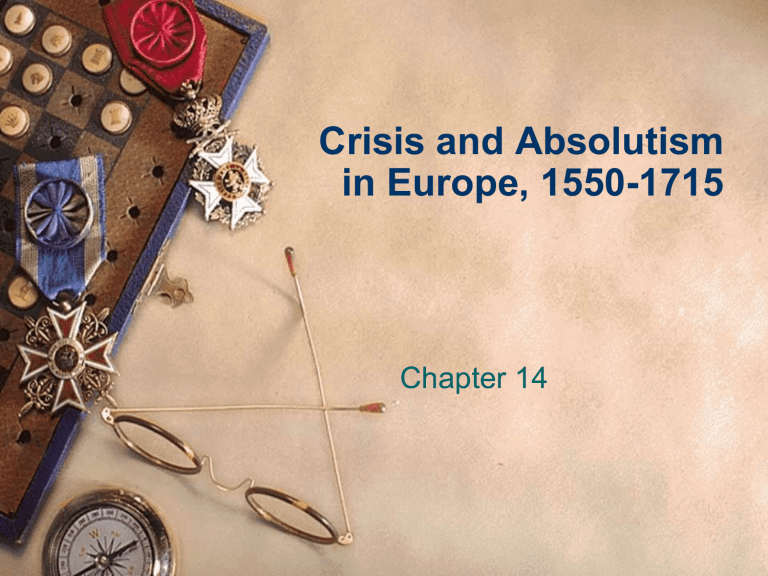
Crisis and Absolutism in Europe, 1550-1715
Chapter 14
Government
Religion
Conflicts
-
Accomplish ments
Spain England France
Introduction
This unit is divided into four parts:
1. Europe in Crisis: The Wars of Religion
2. Social Crises, War, and Revolution
3. Response to Crisis: Absolutism
4. The World of European Culture
1. Europe in Crisis: The Wars of Religion
Key question: What motivated the religious and political conflicts between Catholics and Protestants?
Main idea:
European countries gained and lost power as a result of religious and political conflict.
Europe in Crisis: The Wars of Religion
Main idea:
Catholicism and
Calvinism were engaged in violent conflicts.
These conflicts were present in four countries: Spain, the
Netherlands,
England, and
France.
The French Wars of Religion
1562 to 1598
Religion main cause of war
Catholicism vs.
Calvinism (Huguenots)
The Huguenots were
French Protestants influenced by John
Calvin
The Huguenots were opposed by the “ultra-
Catholics.”
Henry of Navarre
Political leader of the
Huguenots
1589 – became King Henry IV
War ended when Henry IV came to the throne
Converted to Catholicism so he would be accepted by the majority of Catholic France
Henry passed the Edict of
Nantes (1598 ,) which made
Catholicism the official religion of France and allowed
Protestants certain religious freedoms.
Spain: Militant Catholicism
King Philip II : ruled
Spain from 1556-1598
He wanted to combine his territory into one nation (Spain, the
Netherlands, parts of
Italy and the Americas)
He insisted that citizens be Catholic, and he pushed for strong monarchial authority
Spain’s militant Catholicism
Philip II is known as the
“most Catholic king”
Married Mary I of
England
He got Spain involved in battles with the Turks and other groups over religion.
One country that Spain began to disagree with was the Netherlands.
Resistance from the
Netherlands
2.
During this time, Spain controlled parts of what is the present-day
Netherlands and
Belgium
1.
Dutch people did not like
Philip II because he:
Tried to get more control of the region.
Tried to crush
Calvinism
Resistance from the
Netherlands
The leader of the people who opposed Philip II was
William the Silent
The struggle between
Philip II (the Spanish) and
William (the Dutch) lasted until 1609.
The areas under William’s control became the core of the modern-day
Netherlands
Protestantism in England
Elizabeth Tudor : became queen of
England in 1558.
Took throne after her half-sister, Mary (Bloody
Mary)
Elizabeth had to fix a lot of problems that Mary had caused.
Stabilized nation
Died without an heir
Spain & England’s ties
Protestantism in England
Queen Elizabeth was
Protestant, but moderate in her religion.
She tried to keep peace between France and Spain
(if one began getting too strong, she supported the other)
Did not want to go to war with Spain, but could not avoid it
Defeat of the Spanish Armada
1588
King Philip II of Spain ordered an armada (fleet of warships) to invade
England.
The fleet was not strong enough to take on this endeavor
Spain was not strong enough to overthrow England and sailed back to
Spain
– Pounded by storms , ended in disaster
– Many of the Spanish ships sank
– See page 432 for map
Defeat of the Spanish Armada
English ships were smaller and faster
Remaining Spanish ships got stuck in storms
In 1598, Philip II’s reign ended:
– Spain was bankrupt!
– Spain was replaced by France and
England as a world power.
130 about 1900
England; the English ships had more cannons per ship than did the Spanish
Daily Focus
Click the mouse button or press the
Skills
Space Bar to display the answers.
Transparency 1
Go to page 433
Read
Queen Elizabeth’s Golden Speech
Royal Diaries: United Streaming, 26 minutes
2. Social Crises, War, and Revolution
Key question: What effects could have resulted from social, economic, and religious conflicts had on
European countries?
This part of the unit will discuss uprisings throughout Europe
Economic and social crises
Europe suffered from inflation (rising prices) from 1560-1650
Spain’s economy was slowing down because they weren’t finding as much silver
Population began to decrease
Warfare, plague, and famine all contributed to the population decline
The Thirty Years’ War
“the last of the religious wars.”
Began 1618 in Holy Roman
Empire -
Germany/Netherlands
Conflict between Catholics and Protestants (originally)
Denmark, Sweden, France, and Spain got involved
*England was the only
European power not involved
The Thirty Years’ War
As Denmark,
Sweden, France, and
Spain got involved, it became more political
They all wanted to be the strongest nation in Europe
Effects of the War
Settled by the
Peace of
Westphalia
More than 300 states that were formerly part of the
Holy Roman
Empire became independent
Calvinism was not recognized by the peace settlement
Religious disputes continued in Germany after the Peace of
Augsburg in 1555.
By 1660s, Calvinism had spread to many parts of Europe.
From World History:
Connections to Today Prentice
Hall, 2003
Revolutions in England
The English Revolution was going on at the same time as the Thirty Years’ War.
Issue: What roles would the king and
Parliament have in the English government?
The Stuarts and the Divine
Right
Queen Elizabeth died in
1603, ending the Tudor dynasty
The next line of rulers is known as The Stuarts .
The first Stuart ruler was James I,
Elizabeth’s cousin who had been King of
Scotland
The Stuarts and the Divine Right
James I (1603 – 1625) believed his power came from God and that he was responsible only to God.
This idea is called the divine right of kings .
Puritans : Calvinist-Protestants in
England
They did not like James’ strong defense of the Church of England
Had Bible translated from Latin into
English – King James version
The Stuarts and the Divine
Right
The conflict about religion lasted into the reign of his son,
Charles I .(1625 –
1649)
He also believed in the divine right.
Some Puritans got mad and decided to leave… “Pilgrims”
Civil war and Commonwealth
Civil war starts in 1642
-Supporters of the king:
Cavaliers
-Parliamentary forces:
Roundheads
*Parliamentary forces win under the leadership of Oliver
Cromwell
Watch Oliver Cromwell video
Civil war and Commonwealth
Cromwell was put in charge. He:
1. Kicked his opponents out of Parliament.
2. Had Charles I executed.
3. Declared England a commonwealth
(republic)
Cromwell becomes
Lord Protector
Civil war and commonwealth
Cromwell could not get along with his Parliament, so he kicked them out.
Set up a military dictatorship.
Exiled Catholics to Ireland
Strict Puritan laws passed – theaters closed, Sunday set aside for worship, no lewd dancing, taverms or gambling
England – Charles II
The Restoration
1660 - 1685
Charles II - Popular ruler
Monarchy restored –
Hence: Restoration
Bowed to the wishes of
Parliament
Restored the Church of England
Stabilized government
England – William and Mary
English Bill of Rights
1689
William and Mary were given the throne after the
English Bill of Rights was passed.
Guaranteed supremacy of Parliament over the monarchy.
Parliament had to meet on a regular basis
Monarchy could neither make nor suspend laws
Trial by jury reinstated.
Abolished fines and cruel and unusual punishment.
Affirmed “writ of habeas corpus” – no person can be held in prison without first being charged with a specific crime. Due process of laws.
Laid groundwork for American system of laws.
Toleration Act of 1689
Act granted Puritans, but not Catholics, the right of free public worship. Few English citizens, however, would ever again be persecuted for their religion.
DIVINE RIGHT OF KINGS – By deposing one king and establishing another,
Parliament had destroyed the divine-right theory of kingship. “William was, after all, king by the grace of Parliament, not the grace of God.”
3. Response to Crises:
Absolutism
Key question: What effect would the exercise of absolute power have on a nation?
This section will discuss how absolute rulers in Europe built powerful nations and empires.
Response to Crisis: Absolutism
Monarchs needed to increase stability
What they did is known as absolutism
Absolutism : “a system in which a ruler holds total power.
Leading up to Louis XIV
Louis XIII came to the throne when he was a child.
(*oldest son of Henry IV)
Cardinal Richelieu basically ran France until
Louis XIII was old enough
Richelieu strengthened monarchy by taking away
Huguenots’ political and military rights.
Louis XIV Comes to Power
Louis XIV is viewed as the best example of absolutism in the 17 th century.
He was the son of Louis XIII
Officially became king at 4 years old
Cardinal Mazarin ran
France until Louis was old enough.
Louis Comes to Power
Louis XIV officially became king in
1643, but didn’t take over power until
1661.
Known for his love of fun…and for having affairs with his maids.
Government under Louis XIV
Established the royal court at Versailles
Biggest threat to his rule came from nobles who wanted more power.
Louis kicked them out of the royal council.
He forced them to stay busy in court life.
France – Louis XIV
Versailles
Hall of Mirrors
Test Question
King Louis enticed his nobles and royal princes to come to his court, where he could keep them busy with court life and keep them out of politics. (page 443)
Government under Louis XIV
Louis demanded the nobles obey his every wish.
He didn’t share his authority with them.
He had complete power over: foreign policy, religion, and taxes.
Religion under Louis XIV
He wanted religious harmony, so he revoked the Edict of Nantes (tried to convert Huguenots to
Catholicism).
He ordered the destruction of Huguenot churches and schools.
Around 200,000 Huguenots fled to England, Germany, and the Netherlands.
The Economy and War
Louis spent lots of money building palaces and pursuing wars.
In order to increase wealth and power, France followed mercantilism .
They built roads and canals, and raised taxes on foreign goods in order to help
French business.
The Economy and War
He developed a standing army of
400,000.
Louis waged 4 wars between 1667 and
1713.
He wanted to expand his influence throughout Europe.
Legacy of Louis XIV
He died in 1715.
Left France in debt and surrounded by enemies.
His successor was his great-grandson.
Louis advised his successor to not overspend and to try and be at peace with his neighbors.
Absolutism in Central and Eastern Europe
Main idea: Prussia and
Austria emerged as great European powers in the seventeenth and eighteenth centuries.
Prussia and Austria
Prussia: a small territory with no natural frontiers for defense.
Frederick William built a large and efficient army
1701: his son,
Frederick, officially became king
The Hapsburgs and Austria
-
Had long served as emperors in the Holy
Roman Empire
-17 th Century: lost the
German empire
-Austria defeated the
Turks in 1683 and took control of Hungary,
Transylvania, Croatia and Slavonia
Ivan IV Russia
Ivan IV: first Russian ruler to take the title of czar , or
Caesar.
Also called “Ivan the
Terrible” because he was ruthless.
-When his dynasty ended,
The Romanov Dynasty began.
Peter the Great Russia
-Peter: most prominent member of the Romanov family
-He wanted to borrow European technology to modernize the military.
-Won a war against
Sweden and built
St. Petersburg.
4. The World of European
Culture
Key question: How might art, literature, and philosophy be influenced by the turbulence of the time period?
This section will discuss how artists expressed identification with, or reaction to, the issues of the culture.
Art after the Renaissance
European art in the
17 th century was largely focused on religion.
Mannerism
Mannerism : the artistic movement that appeared after the
Renaissance.
It ignored principles of balance, harmony, and moderation
El Greco : seen as the greatest painter of the mannerism period.
The Baroque Period
Mannerism was replaced by the baroque movement
Started in Italy and moved through Europe and to Latin America.
Connected the ideals of the Renaissance and the religious tones of
Mannerism .
The Baroque Period
Greatest figure of the Baroque
Period: Gian
Lorenzo Bernini ,
Italian sculptor and architect.
He completed
Saint Peter’s
Basilica in Rome
Golden Age of Literature
Main idea : Writers in both England and Spain produced classic dramas and comedies between 1580 and
1640.
Shakespeare and England
William Shakespeare : a dramatist during the
Elizabethan Era in
England.
He is known as a writer, but he also acted and owned theaters.
His writing showed understanding of the human condition.
Spain’s Cervantes and Vega
Miguel de
Cervantes wrote
Don Quixote
The book illustrates that visionary dreams and hard work of reality are necessary
Spanish playwright Lope de
Vega
Lope de Vega wrote nearly 1500 plays, 500 of which still exist today.
He openly admitted that the only reason he wrote was to please the audience and to make money.
Political Thought
Main Idea: Thomas Hobbes and
John Locke were two English philosophers during the Age of
Absolutism.
Hobbes
Was very concerned with the uprisings in
England.
Wrote Leviathan , which was about political philosophy
Thought absolute power was necessary to preserve order.
John Locke
Differed from Hobbes
Wrote Two Treatises of
Government
Believed people had natural rights: life, liberty, and property
Claimed people were obligated to revolt if the government was unfair
Quick Review
Why did Hobbes think that absolute power was necessary?
Review Group Activities
French monarchs vs. English monarchs diagram
Identify what you feel are the ten most important terms/concepts from this unit.
Outline the history of England during the Age of
Absolutism
Outline the history of France during the Age of
Absolutism
Summarize European Arts and Culture during the Age of Absolutism
List and describe every monarch we discussed in this unit.

